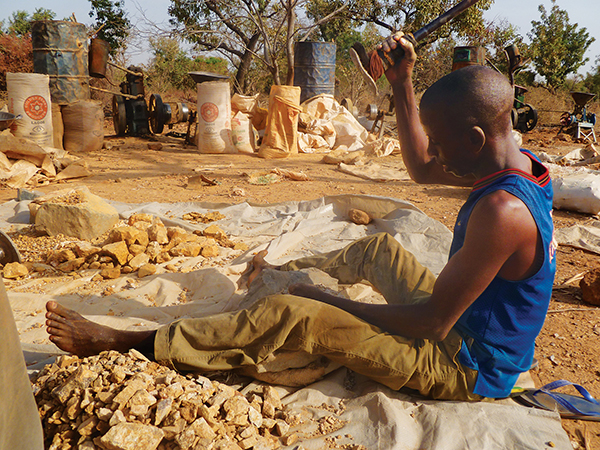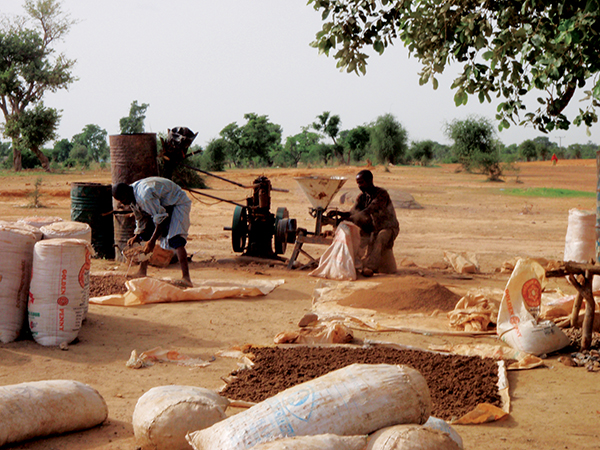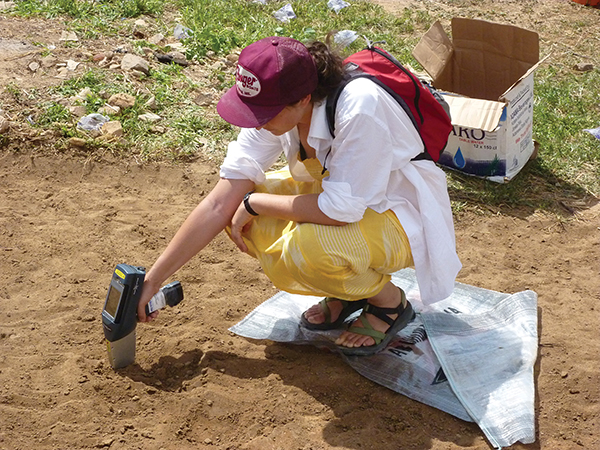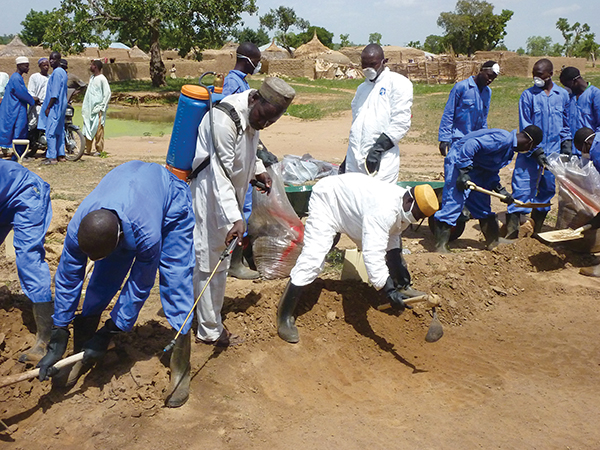
by Kathryn Hansen Wednesday, February 15, 2012

An unprecedented lead poisoning epidemic in Zamfara, Nigeria, is the result of artisanal gold mining operations, where families participate in the gold processing. Courtesy of TerraGraphics Environmental Engineering, Inc.

Nigerian families process gold ore in flour mills. James Durant, ATSDR environmental health scientist

Researchers used portable X-ray Fluorescence Spectrometer technology to characterize the heavy metal concentrations in the soil in Nigeria. Courtesy of TerraGraphics Environmental Engineering, Inc.

Trained local laborers systematically remove the top layer of contaminated soil using locally available tools under the supervision of local and state government supervisors and managers. Courtesy of TerraGraphics Environmental Engineering, Inc.
In March 2010, a team from Médecins Sans Frontières (MSF, or Doctors Without Borders), monitoring for endemic diseases such as meningitis and malaria, visited villages in northwestern Nigeria after being informed by the local community of high mortality in children under five years old. The doctors were not immediately prepared for what they would find. In two villages they discovered children’s fresh graves and a mortality rate of more than 40 percent. Children among the living showed intractable seizures and decreased levels of consciousness. The clues pointed toward a situation massively out of the ordinary, compelling MSF to immediately launch an investigation alongside Nigeria’s state and federal government, the World Health Organization and the U.S. Centers for Disease Control and Prevention (CDC).
What exactly could be causing such an epidemic puzzled the doctors. “There was no robust explanation, no communicable disease, so the team was already thinking about toxins and heavy metals and sent off samples for screening,” says Natalie Thurtle, a doctor with MSF and health advisor for heavy metal poisoning in Zamfara.
The blood sample analysis revealed the culprit: lead. MSF initially screened eight children and two adults for heavy metal poisoning and all samples showed high levels of lead in the blood — above 100 micrograms per deciliter (µg/dL). The CDC investigation team then collected blood samples from 205 children under the age of five from two villages. About 97 percent of the children in this group had lead levels above 45 µg/dL, the threshold for initiating chelation therapy, with some as high as 700 µg/dL. CDC’s “level of concern” is just 10 µg/dL.
The lead contamination, the investigators learned, was coming from the extraction of the Zamfara region’s unusually lead-rich gold ore. Such small-scale subsistence-level mining, called artisanal gold mining, uses rudimentary techniques and the gold ore is processed at home. Unfortunately, Thurtle says, “up to 400 kids died before the multi-agency emergency response was possible.”
Since the issue was identified, the Nigerian federal and state governments, local villagers, international agencies such as MSF, environmental engineers and earth scientists from around the world have been making sense of the amalgam of environmental, economic and cultural information in order to implement solutions for the hardest-hit villages.
The safety hazards associated with artisanal mining have been a growing problem in developing countries, notably in parts of Latin America as well as Venezuela, where workers disappear into a steep open pit and reappear with bags of ore for processing via mercury amalgamation. In many cases it’s the mercury that poses a significant hazard. In Nigeria, even though mercury remains a significant longer-term threat to the environment and to human health, the unprecedented acute health effects to date have come from lead.
To retrieve the lead-rich gold ore, workers in Nigeria are lowered on ropes into holes about 45 meters deep where they mine the ore using rock hammers. Next they bag the ore, transport it on motorbikes to the villages and sell it by the bag to families for processing. The families return to their homes where they crush the lead-rich ore with hammers, or even with mortar and pestle (which they also use to grind their food), and roll it out using metal bars to break it down to a small gravel-like consistency. Next they put it through flour mills to make a fine powder, which is then sluiced — in cooking pots and pans — to concentrate the heavy metals. Finally, the families add liquid mercury to form an amalgam and place the mixture over a fire to evaporate the mercury and collect the gold left behind.
At every step of the process, lead-rich dust makes its way into the environment. Investigators have measured it in the soil, in the floors of living spaces, in the flour mills and mortars and pestles that are sometimes later used to process grain, and in the rivers and wells. Much of the processing and storage occurs in the compounds where families eat and sleep, and children, who are most susceptible to lead poisoning, play.
The Nigerian government asked the CDC for assistance in assessing the two worst-hit villages. In May and June 2010, the CDC team visited the two villages, where they administered a door-to-door questionnaire, measured blood lead levels in children using field meters, collected additional samples of blood for testing back in the United States, and measured environmental lead and mercury using portable field devices.
They also collected a key suite of environmental samples from the soil, from loose soil and dust in family compounds where children eat and sleep, and from the water. They used these results to interpret statistical risk factors for childhood mortality. Their results, published in the journal Environmental Health Perspectives, provided evidence of extreme lead poisoning resulting from exposures created by processing the gold ore.
In October and November 2010, the CDC returned to survey 74 villages throughout Zamfara that, according to reports from MSF and the local Nigerian authorities, were suspected of conducting artisanal gold mining activities. They found evidence of lead contamination or lead-poisoned children in 61 percent of the villages visited.
“The dimensions of the problem are staggering,” says Ian von Lindern of TerraGraphics Environmental Engineering, Inc., who joined the CDC on the initial investigation team in Zamfara and subsequently worked on remediation efforts in villages there. “I’ve been working in this field for about 37 years and have worked on some of the most severe environmental lead poisoning in the United States, but I have seen nothing that rivals this.”
Three main factors combined to create the deadly situation in Nigeria. First, the rising value of gold has encouraged people to exploit many types of ores and waste materials that hadn’t been viable as an economic enterprise before, von Lindern says. In November 2009, Zamfara began exploiting the ore and flour mills were installed to process it. Deaths from lead poisoning started just two months later in January, were discovered and diagnosed by MSF in April, followed by the initial visit from the response team and the CDC in May 2010. Moreover, by 2010, the estimated price of gold was 23 percent higher than in 2009, reported the U.S. Geological Survey (USGS) in an annual mineral commodity summary. Villagers reported they could make as much as $20 per day or more as opposed to just $2 to $3 per day earned from agriculture.
Second, Zamfara is a conservative Muslim community, and women by and large don’t leave the home compounds, says von Lindern, who notes that he saw as many as 15 mothers with small children living together in the compounds. More than 70 percent of households process gold ore inside the compounds, exposing the families to lead dust. In the 12 months preceding the investigation, a quarter of children (118 of 463) under the age of five living in compounds in two villages died of suspected lead poisoning, according to the CDC. For comparison, one child has died of lead poisoning in the U.S. in the last 10 years and 18 children are noted to have died of lead poisoning in Senegal in 2008.
“It’s unusual to find this level of lead contamination in an ore exploited for gold,” von Lindern says. That gives rise to the third set of factors: Zamfara’s geology and environment. Geoff Plumlee, a research geochemist with USGS in Denver, Colo., and colleagues were contacted in late summer 2010 by the CDC and asked to characterize the ore, soil and swept-up samples from an integrated geological and health perspective.
The veins of ore are close to the surface, making them accessible to artisanal mining, Plumlee says. They arise in a series of shear zones in Late Proterozoic-Early Phanerozoic schist and gneiss. Previous analysis of the area suggests that veins in the area are mesothermal (a deposit type now termed orogenic), but Plumlee thinks the abundance of lead is unusual for this type of deposit. “I would have to wonder whether or not the veins are actually a different type of ore deposit,” he says. “Understanding this will be key to addressing where the same geologic environment occurs elsewhere in the world.”
Regardless of how the abundance of lead arose in the gold deposits, the lead’s hazard to health is compounded in a surprising way. The crux of the problem, Plumlee says, is that over the millennia prior to mining, the ores were partially oxidized by weathering, which converted the lead sulfide into a secondary lead mineral assemblage high in lead carbonate and lead oxide. Unlike lead sulfide, lead carbonate is especially problematic because it can quickly dissolve in human stomach acid.
“The geology is the most important factor, but climate also plays a role,” Plumlee says. “Wet or dry makes a difference.”
The geology and climate factors can be overlain with known areas of
artisanal mining, as well as economic and social factors, to anticipate
where this same process might be going on elsewhere in the world,
Plumlee says. “A dent has been already been made in the areas visited,
but how widespread is the issue?”
A meeting of scientists, doctors and politicians in Nigeria was
scheduled for January to discuss the state of the problem, new insights,
and what remains to be done.
So far, teams have remediated seven villages and about 480 compounds and treated more than 3,000 families. MSF doctors started medical treatment for children in June 2010 and now have more than 2,000 children in the program.
The effects of lead poisoning on the body have a wide-ranging clinical and subclinical spectrum, says Thurtle of MSF. Lead binds to sites in the body and prevents ions such as zinc, calcium and iron from binding and carrying out their functions, which can affect every system in the body. The results range from subtle decreases in IQ to seizures, coma, blindness and death. Even if a child recovers from the more severe effects, he or she often suffers brain damage or another life-altering disability.
Chelation therapy works by administering chemicals that form soluble, complex molecules with certain metal ions, to help remove heavy metals from the body. The therapy takes a very long time, Thurtle says, and for some of the children in Zamfara it might take up to 10 years.
“We’re seeing a generation lost in these villages,” von Lindern says. “Survivors will likely have significant brain damage and won’t be fully functional. These are villages that live on the edge, so to have a generation with diminished ability will be a huge problem.”
Medical treatment won’t be worthwhile, however, if the children return to a contaminated environment. Von Lindern and a team from TerraGraphics were on the ground in Zamfara as part of the initial response team. They assisted Zamfara in the phase one emergency remediation from May to July 2010.
“It’s very difficult, but on the other hand simple,” von Lindern says. The team removed the top five centimeters of contaminated soil from the floors of the compounds and other sites and constructed landfills to bury the waste. They collected clean soil excavated from the landfills to haul back to the villages and spread on the ground surfaces. They resurfaced cement floors with fresh cement. They cleaned the wells, ponds, reservoirs and streams in the villages.
The remediation effort is about half done, according to von Lindern. The remediation technique used was purposely designed in a way so villagers and local governments can carry it out themselves.
Villagers have also been taught safer mining techniques. Given the price of gold and the economic realities in these regions, “we know they will not stop mining, and trying to suppress it will only drive it underground,” von Lindern says, “so we want to impose as many safeguards as we can.” The team’s priorities have been to get women and children out of the trade, to centralize operations away from homes and to minimize the spread of dust. That includes working in clean clothes, bathing, setting up kitchens where workers can eat, and keeping them from taking materials and contaminated clothes back home — measures that are not yet systematically implemented or maintained, Thurtle says.
“All of those things make a big difference,” von Lindern says. “Another is working with the Artisanal Gold Council — if they can find ways to make the mining more efficient, then the additional money earned can help offset the costs associated with implementing safer practices.”
Thurtle agrees, adding, “at the end of the day, the key issue is to cease the contamination. In the end, our work is futile if you don’t turn off the tap and have better mining practices.”
Still, there is plenty of work yet to be done, according to Plumlee. “A lot of science is now starting to come out that will essentially underscore that the problem is long term and widespread, and that more needs to be done to help here,” he says.
MSF is aware that lead poisoning and other heavy metal toxicity is an increasing global pandemic, focused in developing countries with complex public health needs and requiring a multidisciplinary approach that is not currently in place, Thurtle says. What USGS can do is show plausible areas where geology can contribute to contamination such as in Zamfara, Plumlee says. “As to the places elsewhere in the world where this could be a problem, this is a key role for economic geology, and it is something on which we are currently working.”
A variety of gold deposit types have associated lead, so it will be important to understand where these deposit types occur in areas being mined artisanally, and also where there are near-surface exposures with the right mix of geology and climate to get the weathering necessary to form secondary lead carbonate minerals, Plumlee says. “That’s perhaps the biggest impact we can have as earth scientists — if we can prevent such tragedies from happening elsewhere.”
© 2008-2021. All rights reserved. Any copying, redistribution or retransmission of any of the contents of this service without the expressed written permission of the American Geosciences Institute is expressly prohibited. Click here for all copyright requests.